Forget Mars, Let's Colonize Venus
Earth's sister planet has much more to offer

» KEY POINTS
- The most Earth-like place in the Solar System is actually floating above the clouds in the skies of Venus.
- With a gravity near that of Earth, an induced magnetic field for protection against cosmic radiation, and the ability to create a perfect perpetual summer environment, Venus is much more appealing than Mars.
- There are far more opportunities to make the transit between Earth and Venus than Earth and Mars, and being closer on average greatly reduces the time it will take to send messages and data between worlds.

Finally, the culmination of your three-and-half month journey is within sight. The long period of weightlessness in the microgravity between planets has left you weaker and your body will need months more of physical therapy to return to what it once was—if you can ever really get it back there. Some calcium loss from your bones is bound to be permanent, and the onboard shielding against radiation was hardly perfect. Though it is not the same as Earth, the gravity here is about 90% the same as what you left behind and you cannot tell the difference. Yet you needed to escape the pull of your home planet in order to start over. That yellow dot in the sky beckoned you with the love and beauty for which she was named.
And now you have entered her crushing embrace. Before you appears the city of Aestas, named for the Roman goddess that is the personification of Summer. Here, floating in the skies of Venus, it will always be just that one season. The warmth in your heart is nothing compared to the extreme temperatures just beyond your protective bubble. Should you ever try to leave this sheltering womb, it would be an irrelevant exercise figuring out which specific factor killed you first. Still, you feel safe and more at home than you ever did back on Earth. You, and many others—perhaps one day millions of others—have set about to colonize and create the world of your dreams.
You have become... Venusian...
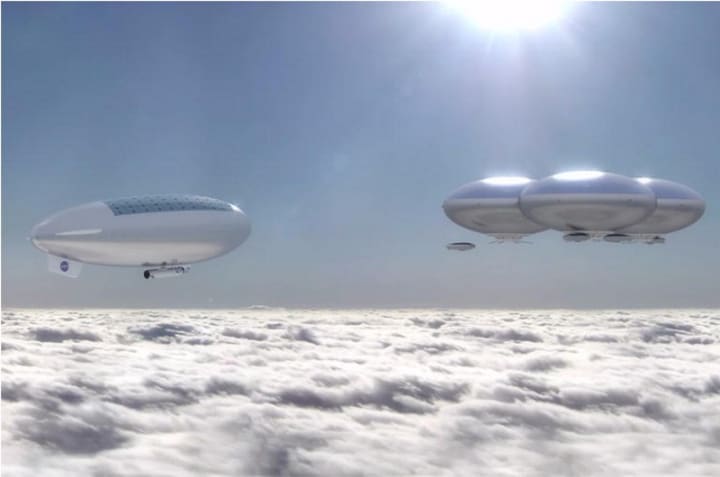
» REDISCOVERING A CLASSIC
The story Aestas—derogatorily nicknamed the “Yellow Balloon” by those who believe it is a waste of time to colonize Venus rather than spend those resources fixing the Earth—will continue another day. Here on the worldline in spacetime that we are on, we are a long way from even returning to Venus in any meaningful way. On June 2, 2021, NASA announced that for the first time since the 1989 to 1994 Magellan mission that the United States would be returning to our sister planet. A little over a week later, the European Space Agency (ESA) also announced their plans to head back to Venus. However, NASA’s mission is scheduled to blast off sometime between 2028 and 2030 and the ESA’s mission is poised for the early 2030s. If everything remains on schedule, it will be at least a decade before we see any data from these enterprises. Judging by the James Webb Space Telescope (announced in 1996, scheduled for launch in 2007, finally left the planet on Christmas Day 2021), the projected timelines may be optimistic.
Thankfully, these are not the only chances to observe the hottest terrestrial object in our solar system. Throughout mid-August 2021 both the ESA’s Solar Orbiter and the joint ESA / Japan Aerospace Exploration Agency (JAXA) craft BepiColombo quickly flew by on their unrelated primary missions. JAXA actually already has a probe named Akatsuki in orbit, which has been there since 2015. It replaced the ESA’s Venus Express that wrapped up its core operations in 2014. Even though the Americans have been negligent, others have tried to pick up the slack.
The ESA released a video of images taken by BepiColombo as it flew by Venus starting on August 10, 2021.
The reason the United States has spent so little energy on Venus is because of their near singular focus on Mars, especially with the concern of one day sending humans and even colonizing the red planet. And sure, Mars does have a lot going for it, but it is nothing compared to the potential for Venus. As stated in part by Gareth Dorrian and Ian Whittaker of Nottingham Trent University in The Daily Galaxy on October 16, 2018:
As surprising as it may seem, the upper atmosphere of Venus is the most Earth-like location in the solar system.
» A PLACE TO LAY MY HEAD
That deep emphasis on Mars comes from one simple fact: we can walk on the surface. While Mars has a very thin atmosphere and provides virtually no protection against cosmic radiation, with proper equipment humans could leave their underground dwellings and walk around outside for a few hours. Still, the majority of any future colonist’s life would be spent under the regolith because that is the only place on Mars that is relatively safe for people, animals, and plants. And frankly, if humans are just going to live bottom-side with limited trips up top, we already have a planet where that is available to us and it is far less resource intensive to get there. Should we just need more space for people, digging into the bedrock here on Earth and creating outposts on the ocean floor are technologically feasible today.

Of course, that is not the only goal of going to Mars; some imagine terraforming it, turning it into a second Earth. Unfortunately, even if such a thing would be possible in the future, Mars is not ideal in this regard. At roughly 38% the gravity of Earth, the human and other Earth-based organisms would not react well in the long term. We are designed for the gravity of our home planet and even a few days in space leaves permanent scars. A lifetime in such an environment may yield health conditions we have not even considered. Meanwhile, as noted above, Venus has a gravity almost the same as Earth, coming in at roughly 90% of it.
Gravity is important for more than just human health, though. Being of a smaller mass, Mars literally cannot hold on to an atmosphere, especially one that would reach the minimal comfort levels for humans (think of the top of a Tibetan mountain). That means there would be an effort to constantly replenish the atmosphere, all while also carrying around portable oxygen. And even if we could keep it up from a ground-level perspective, solar winds from the sun and the rest of the universe would continually strip it away from above, much as what happened to Mars billions of years ago.
Again, because of its relatively smaller size, any rotating liquid metal core that Mars may have had has long since cooled off and seized up. That means it has almost no magnetic field to speak of, which in turn means it has limited protections against the solar winds. The auroras we see on Earth are an indication of the strength of our magnetic field as it captures dangerous solar particles and removes them from directly hitting us and stripping away our own ozone. Our magnetic field is far more important than the atmosphere, in that respect. If you want to see what a body in Earth’s position and with a similar composition looks like without one, peer no further than the moon overhead. The dead world above us started with all of the same building blocks, but like Mars lost any magnetic field and potential atmosphere, essentially killing it.
Now, there is a NASA proposal for generating an artificial magnetic field that could protect a whole planet. Again, though, we may be a long way off from successfully doing this. And at the same time, there is an ethical question if we have a right to terraform an entire planet. Creating a limited human habitation area is one thing; transforming an entire planet destroys the scientific experiments that could be conducted there under natural conditions. Further, we have not explored the entirety of Mars, not even a fraction of 1% in any significant detail. There is still the potential for life there, and if we change the planet to suit our needs we could be committing genocide on a planetary scale. This is something humans have done over and over again to every environment we have visited on our home planet, so perhaps it would be better to leave this one alone, at least for now?
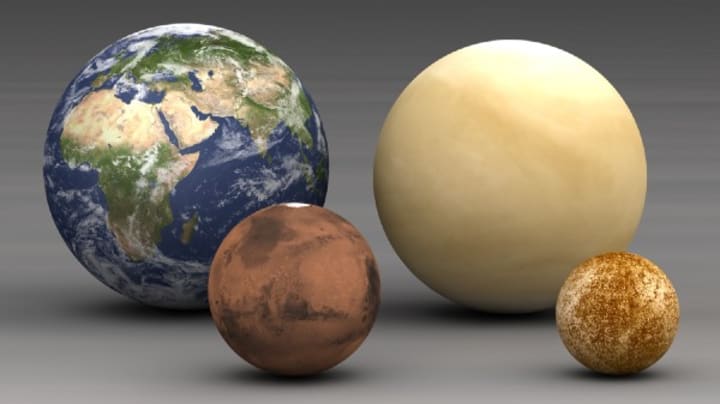
Where, then, does Venus stand in comparison to this? Although Venus is nearly the same size as Earth, some catastrophe in its past caused it to start spinning in the opposite direction of all other planets (save Uranus, which is completely tipped over on its side but would be spinning in the same direction if it was not). And whatever it was—possibly another planet hitting it on its way out of the solar system—made it so Venus is spinning so slowly in the “wrong” direction that a day on the planet (~243 Earth days) is longer than a full rotation around the Sun (~225 Earth days). This is far too slow to generate a magnetic field of its own the way Earth does.
However, thanks to the aforementioned ESA mission we have learned that Venus appears to have an “induced magnetic field”. Without getting too deep into it, this means Venus—without any modification—can provide the protections from dangerous solar radiation that we need to survive. Unfortunately, while that does mean we are safe from one component, Venus’ atmosphere and runaway greenhouse gas effect has created a hellish environment where it is on average 465°C (869°F), which would melt lead—not to mention you—instantly. Not that you could even get to the surface since the pressure is 93 times that of the face of the Earth.
But that brings us back to Aestas. That pressure and temperature is true of the surface, but it is not accurate when describing the upper atmosphere. Were we to fill a balloon full of Earth-like air at a pressure that is livable for humans, it would float like a dirigible. At those heights, the temperature outside the balloon would be around 65–80°C (149–176°F). While still too hot to handle, it is certainly within the range of current refrigeration technology to cool the interior. Or rather—as refrigeration actually works—condensing hot humidity and pushing it back outside, leaving the interior cooler.
Project HAVOK was a NASA study on how to explore and live on Venus. The project was closed without implementing any of the ideas, but they are all still viable.
Now, being a floating city, Aestas would not have to stand still. Instead of being dependent upon the slow and retrograde natural rotation of the planet, the city could literally propel back and forth across the terminus line, creating the illusion of sunrises and sunsets. Sure, the sun would appear to be about 50% bigger compared to Earth, but on Mars it would seem 33% smaller. Also, although Mars is close to the rotation of Earth, a sol (day) there is about 24 hours, 39 minutes, and 35 seconds long. Those extra 39 minutes and 35 seconds may not seem like a lot, but if you try to live in that cycle your entire circadian rhythm would be thrown off. After just a single Earth-year, you will have added an additional 10 Earth-days trying to internalize that extra time. Meanwhile, with Aestas moving freely in the upper atmosphere of Venus, it could be set up to have the same 24 hour-ish cycle we have on Earth.
The other thing to consider is the actual orbit of the planets and their tilt. Earth has two things going for it that create the seasons we have. First is the fact the Earth is tilted on its axis, right now at about 24°. As we orbit the sun, one hemisphere of the Earth is ever so slightly closer to our nearest star while the other is further away, creating Summer and Winter, respectively. However, Summer and Winter in the northern and southern hemispheres are not created equal as Earth actually has an elliptical orbit. In January Earth is closer to the sun than in June, generating an imbalance in how extreme on the hot/cold scale seasons can get. It is where the landmasses and waters are now that makes that difference much less apparent.
Mars—while having a similar 25° tilt—has an orbit that is much more elliptical and extreme than that. A Martian trip around the sun is about twice as long as Earth to begin with, but with its eccentric path the season lengths are all over the place. In the northern hemisphere, the seasons would last:
- Winter: 154 sols
- Spring: 194 sols
- Summer: 178 sols
- Autumn: 142 sols
Now imagine trying to convince Earth plants to adapt to that type of cycle or to store enough food for the long periods without being able to grow. Here it is worth mentioning that the Martian regolith would be highly toxic to Earth plants, even when mixed with Earth soil. As such, no matter where we go, we would have to make our own soil or grow hydroponically until we could make soil. Therefore, with Mars we are again just underground and growing plants in controlled labs. Having land available would not provide any advantage at all.
To further cement this point, on August 18, 2021, a study out of Wageningen University and Research and the Reactor Institute Delft showed the impact of gamma radiation on growing plants. The paper focused specifically on the levels seen on the surface of Mars (almost 17 times that of Earth due to the lack of a magnetic field and thick atmosphere) using greenhouse technology. In the end, the scientists concluded that the only safe location to grow plants on Mars would be beneath the surface, once again showing the fruitlessness of having the vast Martian landscape available.
Meanwhile on Venus, the planet has a tilt of just below 3° and an orbit that is almost a perfect circle. That means, for all intents and purposes, it would always be one season on Venus. Since the environmental controls of Aestas would determine the overall temperature, that season could easily just be early Summer all the time. As a result, the plants could be grown out in the open areas of the colony instead of inside white-walled rooms, using actual sunlight instead of grow-lamps.
At the end of the day, living in the floating city of Aestas on Venus would feel in the literal gravity-based sense very much like being on Earth, except an ideal one with a never-ending Summer and predictability we cannot begin to offer on our homeworld.
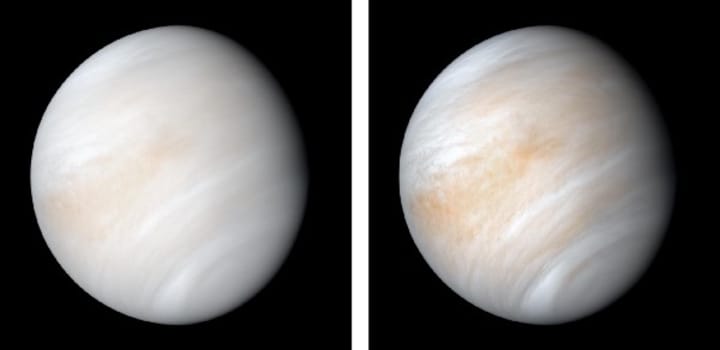
» E.T. NEEDS TO PHONE HOME
Lastly—though in many ways of first import—there is the question of logistics. When it comes to Mars, the closest our two planets get (which is around when we would want to attempt a transfer) comes once every 25–26 months. Yet, because of that same highly elliptical orbit, “closest” has a fairly wide range. In July 2018, Mars made its truly nearest approach at 57.6 million km (35.7 million miles), a feat that will not be repeated until September 2035. Meanwhile, in between, around February 2027 this closest point will be 101 million km (63 million miles) away, nearly double what was seen in 2018.
Venus’ closest approach comes in around 39.8 million km (24.7 million miles), which most recently happened in January 2022. Even missing a window like this, though, is not as big of a deal because these inferior conjunctions happen every 19 months or so and generally fall in the 42–43 million km range (26–27 million miles). As an example, the next pass in August 2023 will actually be a rather distant one at 43.2 million km (26.8 million miles), but still nearer than Mars can ever get. In other words, Venus will always be closer, will have consistently shorter distance trips, and has many more opportunities to move people and goods between our worlds than Mars.
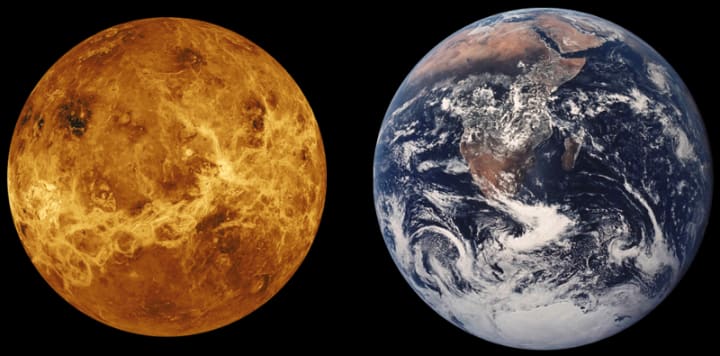
Without diving into the painful math of orbital mechanics, it is fair to note that the energy and time necessary to get into Venusian orbit is not that much less than Martian, almost to the point of being negligible. In many ways, it is easier to go outbound in the solar system than to go inbound. That, though, is with today’s technology and infrastructure. Future situations may change these equations greatly, but we will not speculate here.
Instead, let us again focus in on that distance measurement. The finite speed within the universe is limited to that of light, so any communication tool we use will also be at most that velocity. Assuming we can send data at near the speed of light (which we already do on Earth with fiber-optics), then Venus is again going to be the hands-down winner on keeping up with our far-flung cousins. Looking at how fast light moves between our worlds:
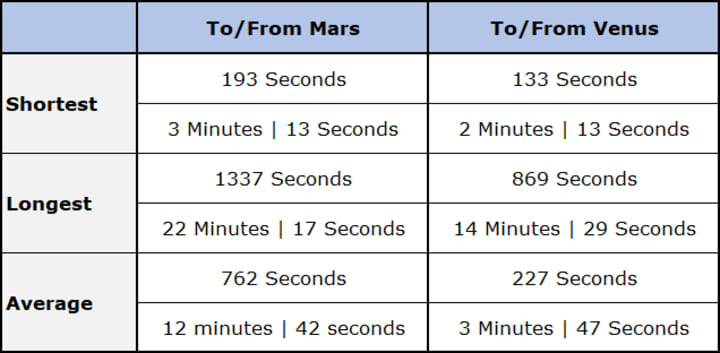
Since Venus will be closer more often on average than Mars, there are far more opportunities for faster communication, hence the average time being less than 4 minutes instead nearly 13 minutes. While that is certainly not real time (and you have to double it for two-way communication), it is very comfortable lengths for a text/messenger style conversation. And communication will be critical when we are talking about the isolation and separation of building a colony on a whole new world.
No matter which way it is sliced, Venus is the superior destination when it comes to being the launching point for humanity’s propagation to the stars, at least in comparison to Mars. Not that we should abandon scientific research of Mars, nor should we give up sending astronauts there for study—but when it comes to building a new home, there is nowhere else quite like above the yellow skies of Venus.

The above piece is an excerpt from Always Divided, Never United: And Other Stories During a Time of Pandemics and Politics by J.P. Prag, available at booksellers worldwide.

Learn more about author J.P. Prag at www.jpprag.com.

An earlier version of this article appeared on Medium.
About the Creator
J.P. Prag
J.P. Prag is the author of "Aestas ¤ The Yellow Balloon", "Compendium of Humanity's End", "254 Days to Impeachment", "Always Divided, Never United", "New & Improved: The United States of America", and more! Learn more at www.jpprag.com.
Enjoyed the story? Support the Creator.
Subscribe for free to receive all their stories in your feed. You could also pledge your support or give them a one-off tip, letting them know you appreciate their work.


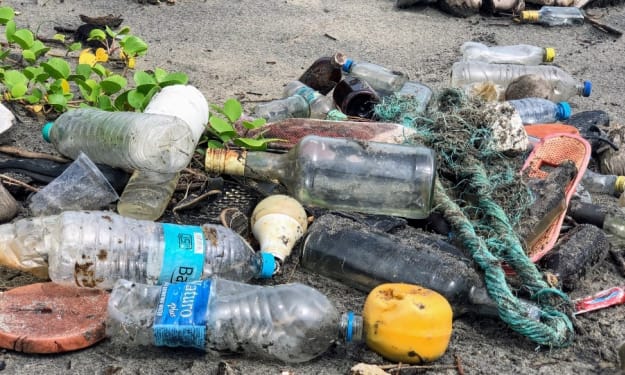



Comments
There are no comments for this story
Be the first to respond and start the conversation.